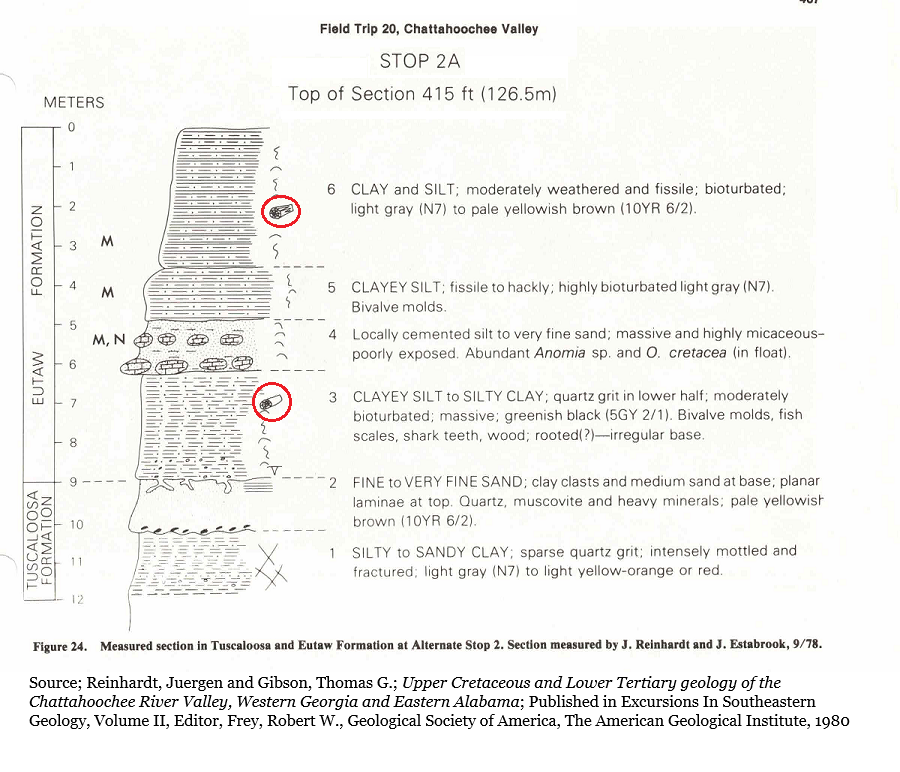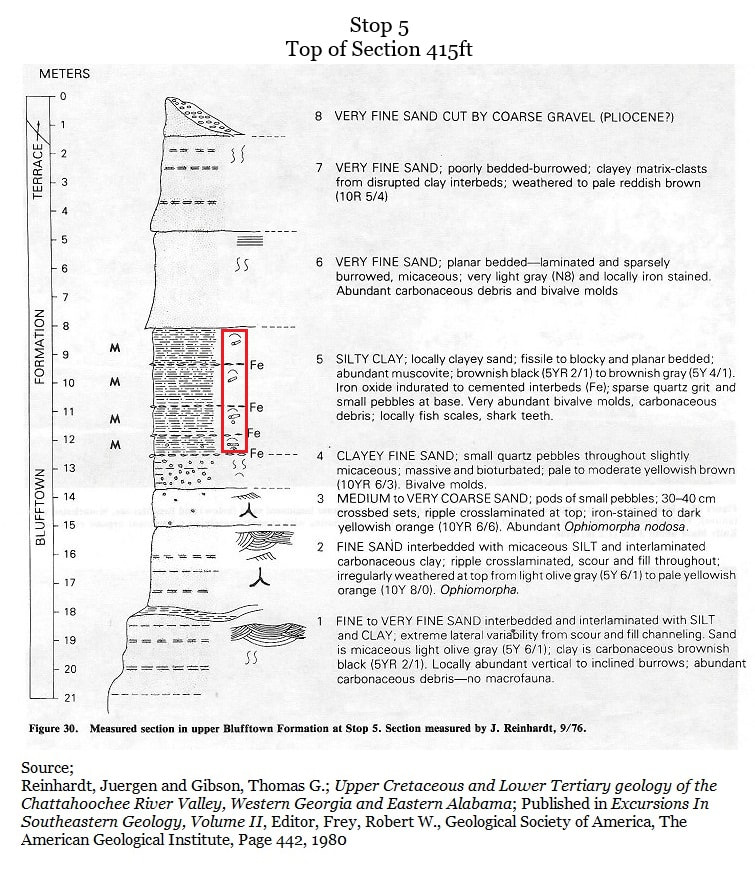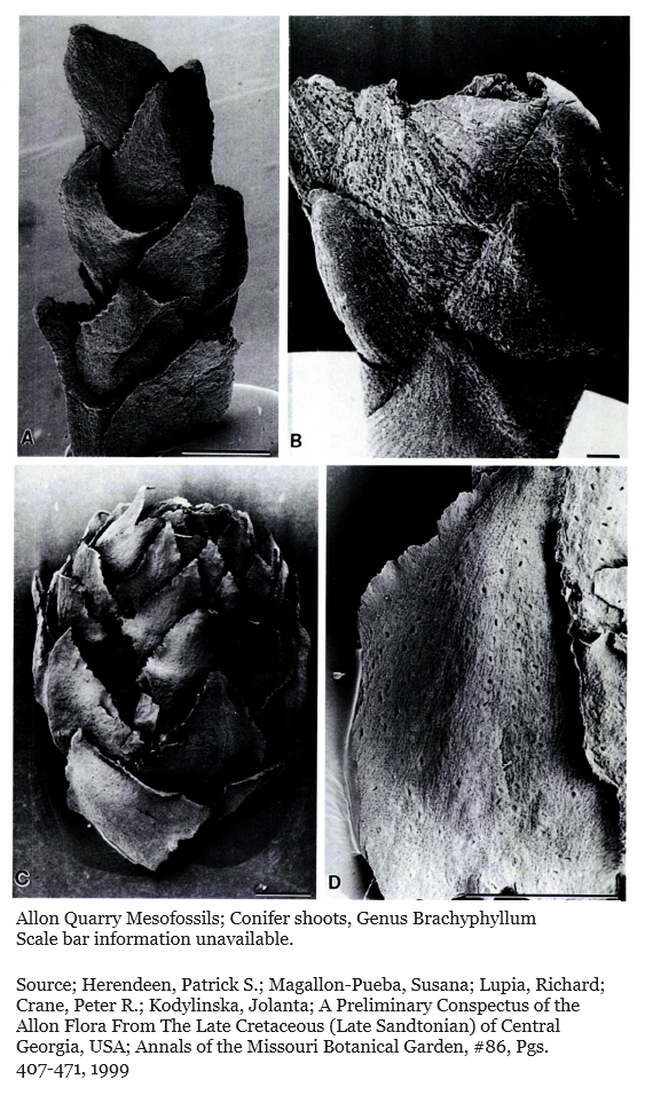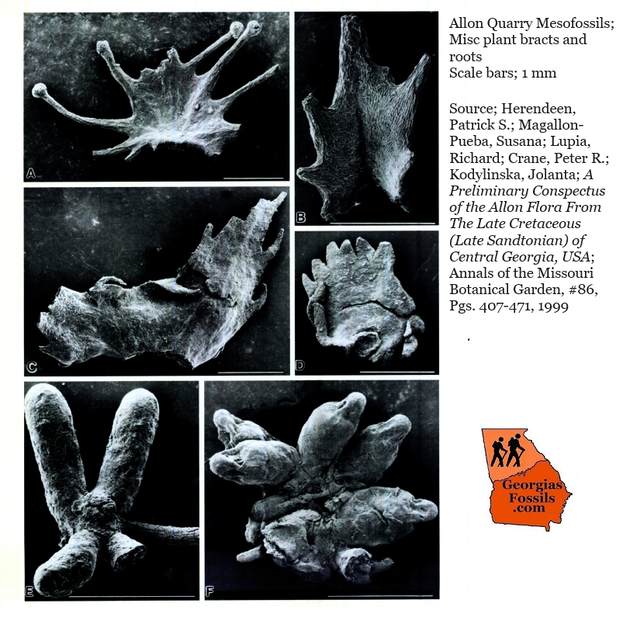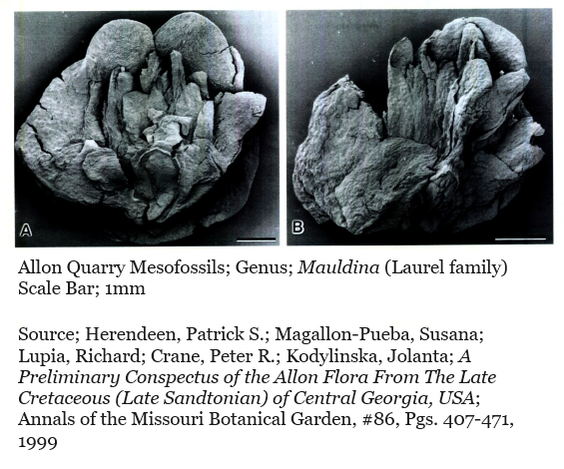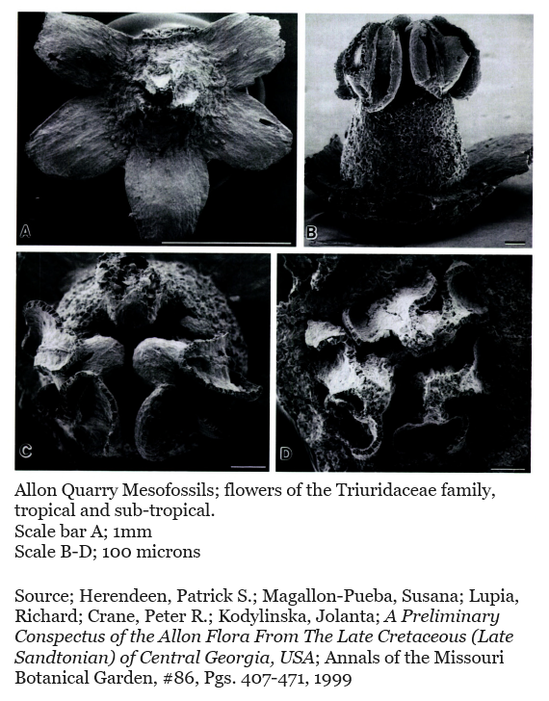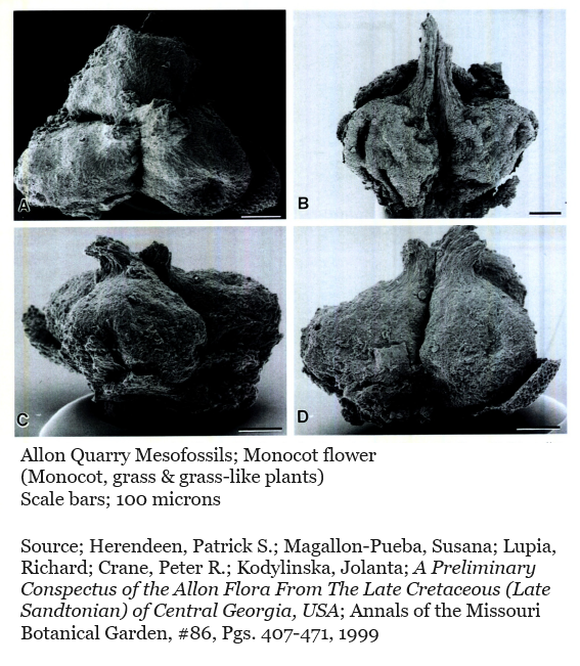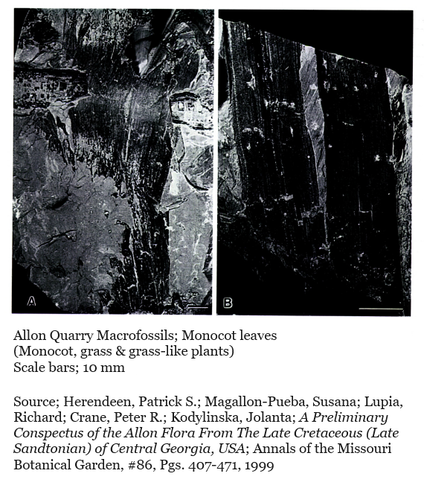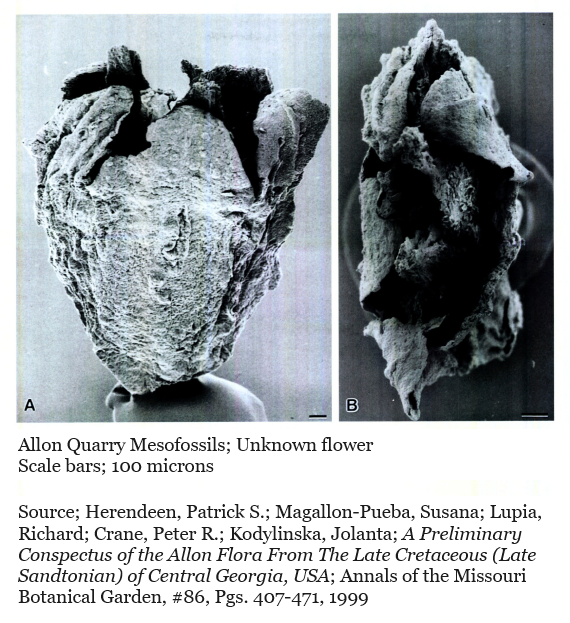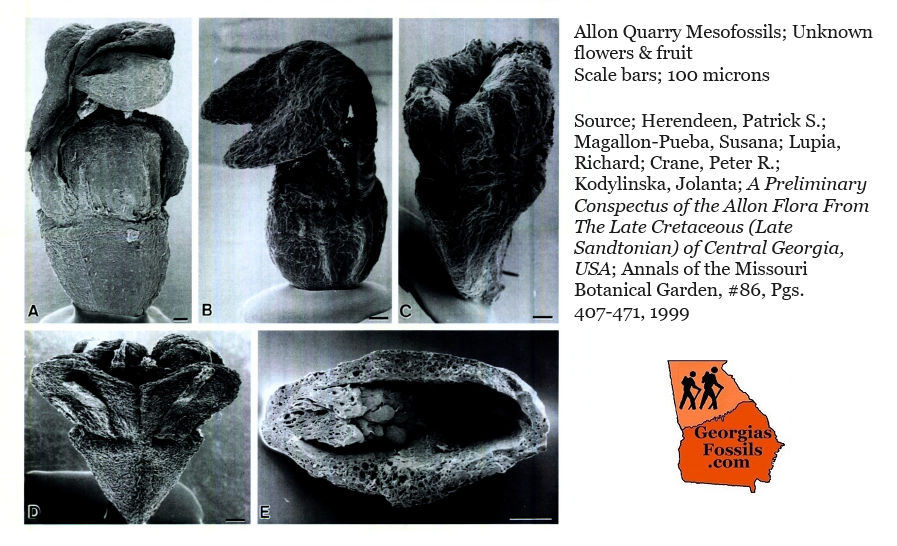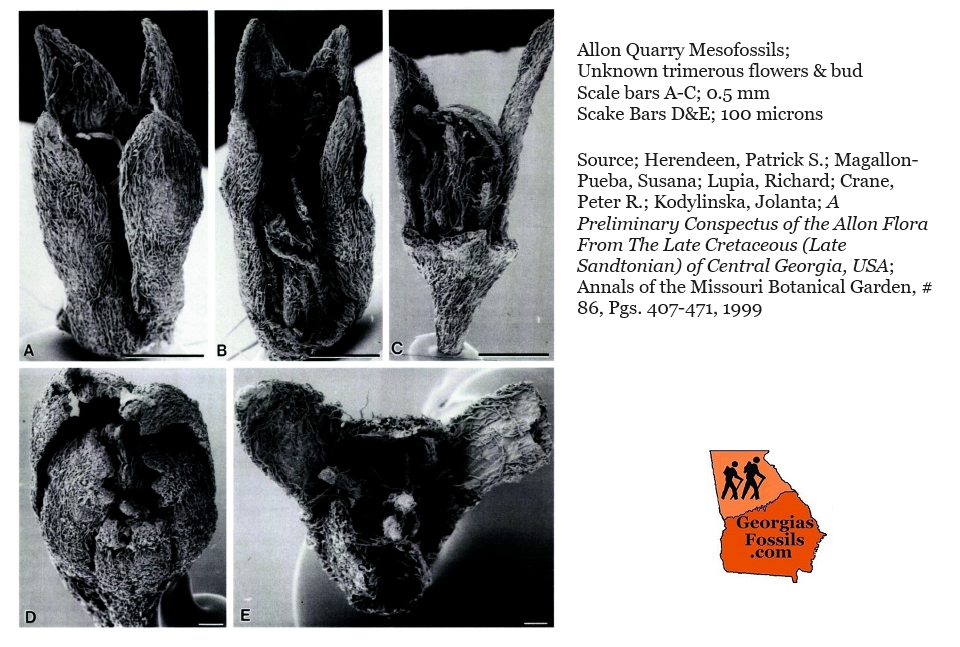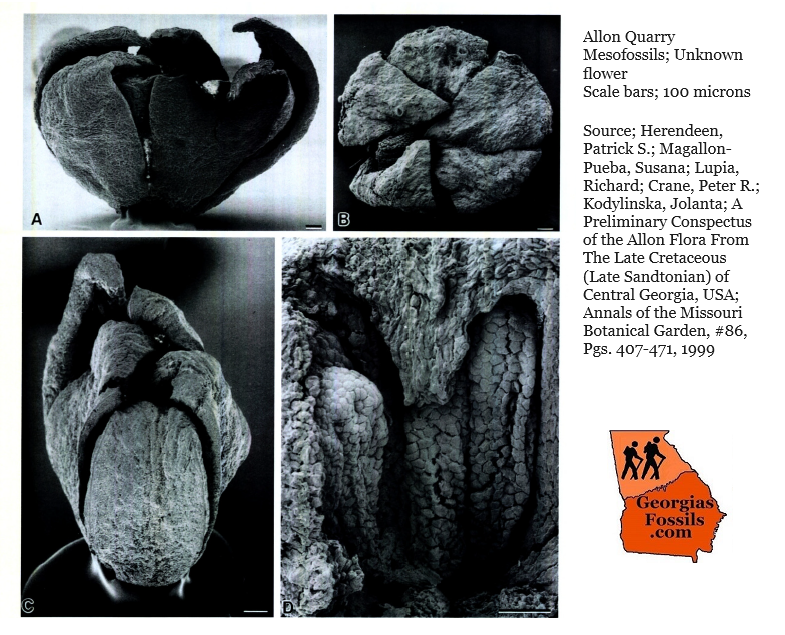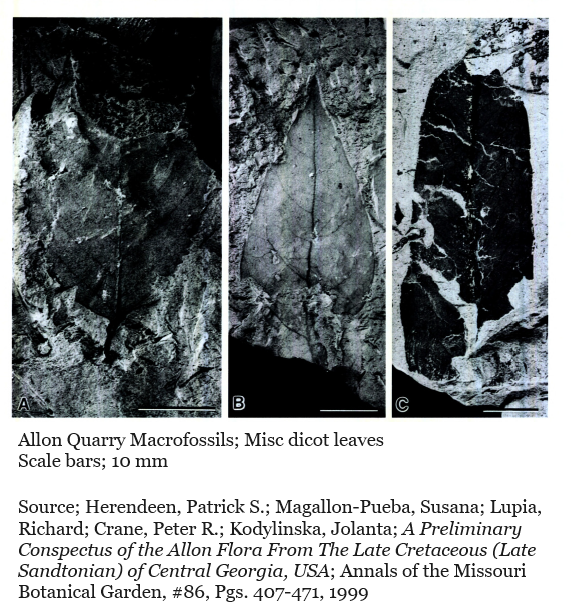7K: Cretaceous Mesofossils
Plants of
Crawford County, GA
By Thomas Thurman
Posted 01/Oct/2023
In 1999 a research team led by Patrick S. Herendeen reported an array of dinsosaur-time plant fossils from Atlanta Sand Company’s Allon Quarry in Crawford County, between Roberta and Fort Valley. They found of mosses, ferns, conifers, laurels, magnolias, witch hazel and others in kaolin of the Cretaceous Period. In their earlier papers they’d estimated the age of the deposit at 80 million years, subsequent work revised this, moving the date back to roughly 84 million years.
This has proven to be important work at an important site, new genus and species of plants have been discovered and described.
Pat Herendeen is the Senior Director of Plant Biology of the Chicago Botanic Garden and a lecturer in evolutionary biology. The fossils Herendeen’s team collected from Crawford County were all deposited for safe keeping in the Department of Geology of the Field Museum in Chicago, Illinois.
Pat Herendeen is the Senior Director of Plant Biology of the Chicago Botanic Garden and a lecturer in evolutionary biology. The fossils Herendeen’s team collected from Crawford County were all deposited for safe keeping in the Department of Geology of the Field Museum in Chicago, Illinois.
Yes, dinosaurs walked Georgia when these plants lived. Georgia has a good record of fossils from this timeframe, including dinosaurs, but the vast majority of these fossils come from the Chattahoochee River Valley, 60 miles west of quarry in Crawford County.
I shared the research papers over these finds with Dr. David Schwimmer at Columbus State University. Schwimmer, of course, is the leading expert on the Chattahoochee River Valley Cretaceous deposits and the vertebrate remains they hold. “Thanks for sharing this, Thomas. I have lots of fossil wood of the same age from my sites, both coal and petrified, never really studied. Hard to get students interested compared with dinosaurs. Cheers. David”
Plant fossils tell us about past environments.
I shared the research papers over these finds with Dr. David Schwimmer at Columbus State University. Schwimmer, of course, is the leading expert on the Chattahoochee River Valley Cretaceous deposits and the vertebrate remains they hold. “Thanks for sharing this, Thomas. I have lots of fossil wood of the same age from my sites, both coal and petrified, never really studied. Hard to get students interested compared with dinosaurs. Cheers. David”
Plant fossils tell us about past environments.
Mesofossils
Herendeen’s research team was looking at mesofossils from Crawford County, roughly 58 miles east of the Chattahoochee River in Columbus, GA.
Mesofossils are small, but not microscopic. They can be seen with the naked eye, but like the mustard seed, magnification is required to observe details. Herendeen’s research team reports finding “extremely well preserved” flowers, fruits, seeds, stamens, wood, cones, pollen organs, fern pinnules, rhizomes… Specimens were often lignified (brown coal) or charcoalified but both modes can be easily studied by scanning electron microscopy. Herendeen notes that the Crawford County “Charcoalified specimens, in particular, are often exquisitely preserved and yield a level of fine structural detail comparable to that obtained from extant (modern) plants.”
Herendeen’s research team was looking at mesofossils from Crawford County, roughly 58 miles east of the Chattahoochee River in Columbus, GA.
Mesofossils are small, but not microscopic. They can be seen with the naked eye, but like the mustard seed, magnification is required to observe details. Herendeen’s research team reports finding “extremely well preserved” flowers, fruits, seeds, stamens, wood, cones, pollen organs, fern pinnules, rhizomes… Specimens were often lignified (brown coal) or charcoalified but both modes can be easily studied by scanning electron microscopy. Herendeen notes that the Crawford County “Charcoalified specimens, in particular, are often exquisitely preserved and yield a level of fine structural detail comparable to that obtained from extant (modern) plants.”

Mesofossil research has created a pronounced change in our understanding of Cretaceous flowering plants (angiosperms). Scientific research like we’re reviewing here conducted in Europe and Eastern North America has significantly extended our current knowledge of many angiosperm groups.
Pollen is frequently preserved within the plant reproductive structures and this has led to the identification of parent plants for many Cretaceous species, expanding the current knowledge of plant ranges.
The fossils were collected by washing Buffalo Creek Member kaolin through sieves with down to 125 microns, such sieves are readily available. Fossil images were created with a scanning electron microscope, but much of this could be seen with a standard biological microscope.
Pollen is frequently preserved within the plant reproductive structures and this has led to the identification of parent plants for many Cretaceous species, expanding the current knowledge of plant ranges.
The fossils were collected by washing Buffalo Creek Member kaolin through sieves with down to 125 microns, such sieves are readily available. Fossil images were created with a scanning electron microscope, but much of this could be seen with a standard biological microscope.
Past Exploration
Sadly, the Chattahoochee River Valley plant fossils have not been well documented since 1911 and Herendeen was unaware of the 1911 reports. It wasn’t a paleobotany paper but a general survey. Neither was he aware of a 1980 field trip report by Jurgen Reinhardt over Cretaceous through Early Eocene deposits of the Chattahoochee River Valley. The 1980 Reinhardt paper has just been digitalized and made available online.
See this website, section 7J: Field Trip Report, Chattahoochee River Valley 1980 Creataceous, Paleocene, & Eocene
Sadly, the Chattahoochee River Valley plant fossils have not been well documented since 1911 and Herendeen was unaware of the 1911 reports. It wasn’t a paleobotany paper but a general survey. Neither was he aware of a 1980 field trip report by Jurgen Reinhardt over Cretaceous through Early Eocene deposits of the Chattahoochee River Valley. The 1980 Reinhardt paper has just been digitalized and made available online.
See this website, section 7J: Field Trip Report, Chattahoochee River Valley 1980 Creataceous, Paleocene, & Eocene

GeorgiasFossils.com (Thomas Thurman) received permission to digitalize the 1980 field trip report and post it from free download.
Ryan Rooney at Tellus Science Museum in Cartersville scanned and created the PDF.
We're deeply grateful for the Tellus assist!
Ryan Rooney at Tellus Science Museum in Cartersville scanned and created the PDF.
We're deeply grateful for the Tellus assist!
The plants we’ll be reviewing here lived tens of millions of years before the oldest stone tools, before the first hominids, our ancestors, walked the Earth. Our hominid linage emerged about 17 million years ago, our genus only about 3 million years old. We’re reminded that the Earth is staggeringly old.
Veatch & Stephenson; 1911 Cretaceous plants
The Veatch and Stephenson Cretaceous report is explored in some detail is Section 22A of this website. Without repeating location details here, Veatch and Stephenson reported the following plants as occurring in the Chattahoochee River Valley. These species are adapted from lists created in 1911, and I’ve tried to use current nomenclature.
The Veatch and Stephenson Cretaceous report is explored in some detail is Section 22A of this website. Without repeating location details here, Veatch and Stephenson reported the following plants as occurring in the Chattahoochee River Valley. These species are adapted from lists created in 1911, and I’ve tried to use current nomenclature.
Scientific Name Common Name
Andromeda cretacea Heath family, Flowering plant
Andromeda novae-caesareae Heath family
Andromeda wardiana Heath Family, Flowering plant
Androvettia elegans Conifer
Aralia eutawensis Flowering shrub or tree
Araucaria bladenensis Evergreen conifer
Araucaria jefferyi Conifer
Brachyphyllum macrocarpum Conifer
Cinnamomum heeri Cinnamon tree, Laurel family
Cinnamomum newberryi Cinnamon tree, Laurel family
Cunninghamites elegans Conifer
Doryanthophyllum cretaceum No Information Found, likely reassigned.
Dryopteris Fern
Eucalyptus angusta Eucalyptus, Myrtle family
Ficus (Species?) Fig
Ficus crassipes Round-leafed banana fig
Ficus krausiana Fig tree
Ficus ovatifolia Fig tree or shrub
Juglans arctica Walnut family
Magnolia boulayana Magnolia; common Southeastern flowering tree
Magnolia capellinii Magnolia; common Southeastern flowering tree
Malapoenna horrellensis Laurel family
Manihotoides (Species?) Manihot, spurge, related to Cassava
Manihotoides georgiana Manihot, spurge, related to Cassava
Menispermites variabilis Related to curare plant; Family; Menispermaceae
Monocotyledon (Species?) Monocot; family including daylilies & wheat
Paliurus upatoiensis Species of flowering shrub or small tree
Phragmites pratti Reed, perennial grass
Salix eutawensis Willow family
Salix flexuosa Willow family
Salix lesquereuxii Willow family
Sequoia reichenbachi Sequoia, Cypress family
Tumion carolinianum Genus; Torreya; related to Nutmeg Yew
Zizyphus laurifolious Related to Buckthorn
Andromeda cretacea Heath family, Flowering plant
Andromeda novae-caesareae Heath family
Andromeda wardiana Heath Family, Flowering plant
Androvettia elegans Conifer
Aralia eutawensis Flowering shrub or tree
Araucaria bladenensis Evergreen conifer
Araucaria jefferyi Conifer
Brachyphyllum macrocarpum Conifer
Cinnamomum heeri Cinnamon tree, Laurel family
Cinnamomum newberryi Cinnamon tree, Laurel family
Cunninghamites elegans Conifer
Doryanthophyllum cretaceum No Information Found, likely reassigned.
Dryopteris Fern
Eucalyptus angusta Eucalyptus, Myrtle family
Ficus (Species?) Fig
Ficus crassipes Round-leafed banana fig
Ficus krausiana Fig tree
Ficus ovatifolia Fig tree or shrub
Juglans arctica Walnut family
Magnolia boulayana Magnolia; common Southeastern flowering tree
Magnolia capellinii Magnolia; common Southeastern flowering tree
Malapoenna horrellensis Laurel family
Manihotoides (Species?) Manihot, spurge, related to Cassava
Manihotoides georgiana Manihot, spurge, related to Cassava
Menispermites variabilis Related to curare plant; Family; Menispermaceae
Monocotyledon (Species?) Monocot; family including daylilies & wheat
Paliurus upatoiensis Species of flowering shrub or small tree
Phragmites pratti Reed, perennial grass
Salix eutawensis Willow family
Salix flexuosa Willow family
Salix lesquereuxii Willow family
Sequoia reichenbachi Sequoia, Cypress family
Tumion carolinianum Genus; Torreya; related to Nutmeg Yew
Zizyphus laurifolious Related to Buckthorn
Of course, in the last 112 years the age of many sediments beds have been adjusted and species have been reassigned as researchers have continually refined and sharpened our understanding of the distant past.
1980 Field Trip
Chattahoochee River Valley
In 1980 Jurgen Reinhardt of the USGS and Thomas G. Gibson of the U.S. National Museum (now the Smithsonian NMNH) published a major paper on the Chattahoochee River Valley around a field trip of the Geological Society of America.
Chattahoochee River Valley
In 1980 Jurgen Reinhardt of the USGS and Thomas G. Gibson of the U.S. National Museum (now the Smithsonian NMNH) published a major paper on the Chattahoochee River Valley around a field trip of the Geological Society of America.
While the 1980 paper isn’t a paleobotany paper, its important as the researchers visited many sites where carbonaceous debris (fossilized plant material) was present. They created an excellent record, published many stratigraphic column section drawings, and published sediment dates based on fossil content. Most of the fossil wood was lignite (brown coal), though some was silicified. The authors often illustrated Cretaceous logs in their section drawings.
Simply put, Reinhardt & Gibson created a very important Late Cretaceous to Early Eocene research paper on the Chattahoochee River Valley.
For paleobotany, the illustrated stratigraphic section drawings often show logs in the deposits. To my knowledge there has been little to no follow-up on the plant material.
The field trip began in Phenix City Alabama, travelled south to Eufaula, Alabama, crossed into Georgia and travelled north through Lumpkin and Cusseta and back to Columbus, Georgia. The field team showed conclusively that an abundance of plant material was preserved in the Chattahoochee Valley.
For paleobotany, the illustrated stratigraphic section drawings often show logs in the deposits. To my knowledge there has been little to no follow-up on the plant material.
The field trip began in Phenix City Alabama, travelled south to Eufaula, Alabama, crossed into Georgia and travelled north through Lumpkin and Cusseta and back to Columbus, Georgia. The field team showed conclusively that an abundance of plant material was preserved in the Chattahoochee Valley.
I should add here that Jurgen Reinhardt, the lead author, is no longer with us. He died in an automobile accident some decades ago.
1980 Reviewed Formations & Approximate Age
The field trip reviewed, dated, and described the following beds, beds where they reported plant material are marked.
Eocene (Lower)
Hatchetigbee Formation
55 million years old
Palocene (Upper)
Tuscahoma Formation (Plant Material)
56.5 million years old
Nanafalia Formation (Plant Material)
57.5 to 59 million years old
Porters Creek Clay
62 million years old
Paleocene (Lower)
Clayton Formation (Plant Material)
64 million years old
Cretaceous (Upper)
Providence Sand (Plant Material)
67 million years old
Perote Member (Plant Material)
Of Providence Sand
68 million years old
Ripley Formation
70 million years old
Cusseta Sand
71 million years old
Blufftown Formation (Plant Material)
77 million years old
Eutaw Formation (Plant Material)
84 million years old
Tuscaloosa Formation
95 million years old
Crystalline Basement Rock
Suspected 150+ million years old (?)
The field trip reviewed, dated, and described the following beds, beds where they reported plant material are marked.
Eocene (Lower)
Hatchetigbee Formation
55 million years old
Palocene (Upper)
Tuscahoma Formation (Plant Material)
56.5 million years old
Nanafalia Formation (Plant Material)
57.5 to 59 million years old
Porters Creek Clay
62 million years old
Paleocene (Lower)
Clayton Formation (Plant Material)
64 million years old
Cretaceous (Upper)
Providence Sand (Plant Material)
67 million years old
Perote Member (Plant Material)
Of Providence Sand
68 million years old
Ripley Formation
70 million years old
Cusseta Sand
71 million years old
Blufftown Formation (Plant Material)
77 million years old
Eutaw Formation (Plant Material)
84 million years old
Tuscaloosa Formation
95 million years old
Crystalline Basement Rock
Suspected 150+ million years old (?)
As many of you know I’m well experienced in the field and have spent some time looking for these exposures. My success has varied. Hank Josey, who’s contributed several essays to this website, has also explored these old locations and known more success than I in locating several. We visited the Nanafalia Formation in May of 2020.
After more than 40 years many of the 1980 sites are extinct, overgrown, or inaccessible. Though the formations may differ a bit from site to site, they don’t change dramatically. It should be possible retrace or recreate this field trip. It should be possible to confirm the findings from 1980 and expand on that research.
After more than 40 years many of the 1980 sites are extinct, overgrown, or inaccessible. Though the formations may differ a bit from site to site, they don’t change dramatically. It should be possible retrace or recreate this field trip. It should be possible to confirm the findings from 1980 and expand on that research.
1999 Report on Atlanta Sand Cretaceous Plants
Herendeen’s 1999 paper shines a light on Central Georgia’s Cretaceous material, showing that the Cretaceous flora of Chattahoochee River Valley stretched well eastward into Central Georgia. Perhaps the same can be said for Paleocene and Early Eocene flora, but evidence has yet to present itself. However, the 1911 account discussed above certainly reports Late Eocene plants in Central Georgia and, as we saw in Section 9B (this website) over the Sassafras Hill quarry, Paleocene plants also occur in Central Georgia.
Herendeen’s 1999 paper shines a light on Central Georgia’s Cretaceous material, showing that the Cretaceous flora of Chattahoochee River Valley stretched well eastward into Central Georgia. Perhaps the same can be said for Paleocene and Early Eocene flora, but evidence has yet to present itself. However, the 1911 account discussed above certainly reports Late Eocene plants in Central Georgia and, as we saw in Section 9B (this website) over the Sassafras Hill quarry, Paleocene plants also occur in Central Georgia.
The Allon Quarry research team was unaware of the 1911 and 1980 research, but they were very familiar with Edward William Berry’s 1914 paper on plant fossils from the Upper Cretaceous and Eocene deposits of Georgia and South Carolina. Berry was advised on collecting localities by the adventurous geologist S. W. McCallie (Georgia State Geologist from 1908 to 1933) and recovered his samples from the Chattahoochee River Valley.
We’ll look at Edward Berry’s 1914 work, in some detail, on another page.
We’ll look at Edward Berry’s 1914 work, in some detail, on another page.
But in Crawford County Herendeen’s team reports a wealth of material often exquisitely preserved.
Buffalo Creek Kaolin Member
The fossils were collected by washing the gray kaolin of the Gaillard Formation through sieves with the finest being 125 microns. The material was dried, fossils isolated, and images were created with a scanning electron microscope. But as mesofossils they are visible to the naked eye and a standard biological microscope should be sufficient for amateurs to see some detail.
The fossils were collected by washing the gray kaolin of the Gaillard Formation through sieves with the finest being 125 microns. The material was dried, fossils isolated, and images were created with a scanning electron microscope. But as mesofossils they are visible to the naked eye and a standard biological microscope should be sufficient for amateurs to see some detail.
The fossil bearing bed of the Buffalo Creek Kaolin was a clay lens in the Allon's south pit. The lens was .2 to .8 meters (8 to 31”) thick, truncated at each end, and extended laterally at least 16 meters (52’). The clay is microlaminated, dark gray, and carbonaceous. Its interpreted as representing a lower floodplain pond, and the presence of rare dinoflagellates in the palynoflora (microscopic organic particles) indicates some possible tidal influence.
The Buffalo Creek Kaolin Member is the same age as the Eutaw Formation in the Chattahoochee River Valley, just slightly different environments.
The Buffalo Creek Kaolin Member is the same age as the Eutaw Formation in the Chattahoochee River Valley, just slightly different environments.
This lens produced about 250 specimens per 20 kilogram (44 pounds) sample where the lens is thick, to 2500 specimens per 20 kilogram sample at the extreme edge where the lens is thinnest.
The researchers report considerable variation in mesofossil composition among different samples. There is a diverse assemblage of angiosperms, gymnosperms, ferns, and bryophytes preserved as fusainized and lignitic (two types of charcoal) mesofossils. The clay also contains macrofossils preserved as impressions or think compressions as well as diverse palynoflora.
The authors sate emphatically; “Future research on the Allon flora will undoubtedly result in the recognition of new taxa.”
Fossil Plants Collected in Crawford County
Note how many species now have “Allon” incorporated in their name, these are newly named from Crawford County.
Note how many species now have “Allon” incorporated in their name, these are newly named from Crawford County.
Fossil Plants Collected in Crawford County
Note how many species now have “Allon” incorporated in their name, these are newly named from Crawford County.
Mosses
First definitive evidence that modern mosses lived in the Cretaceous.
Eopolytrichum antiquum Moss (New species)
Campylopodium allonense Moss (New species)
Ferns
Genus; Boodlepteris Fern
Incertae sedis (uncertain) Fern
Dryopterites? Fern leaf type 2 (macrofossil)
Similar to specimen from
GA Eutaw Formation
Conifer
There is evidence for several unidentified conifers which require further study.
Incertae sedis (uncertain) Multiple unidentified conifer foliage
(Many leafy shoot fragments and isolated leaves have been found.)
Angiosperms
Magnolia
Genus; Destrusandra Magnolia family, 3 specimens
Laurals
Genus; Mauldinia Preserved as compressed lignite.
Perhaps most common angiosperm
Triuridaceae
Tropical/subtropical family No photosynthesis, digests fungi
5 specimens preserved.
Monocot (Grass or grass-like)
Incertae sedis (uncertain) Tri-carpel flower, 2 specimens
Incertae sedis (uncertain) Two distinct leaf types, 1 specimen
Hamamelidaceae (Witch hazel family)
Allonia decandra Flower, 1 incomplete
Unknown Small flower
Unidentified capitate inflorescence Flower cluster
Fagaceae (Family including beeches, chestnuts & oaks)
Protofagacea allonensis New Species; Flowers, fruits, & other parts Abundantly represented
Antiquacupula sulcate New species, flowers, fruits and other parts
Five Specimens
Genus; Caryanthus Flowering plant
Typically perennial herd
Normapolles flower type Extinct pollen type
Widespread in Cretaceous
Betulaceae (Family of birch, alders, hazel, hornbean and other trees.)
Bedellia pusilla Flower
4 specimens
Actinidiaceae (Small trees, shrubs, or vines)
Parasaurauia allonensis New genus & species
Family of shrubs & bushes
Unidentified
Miscellaneous Angiosperm Flowers, Fruits, & Other Structures
Clearly there is more work to be done.
14 Flowers
4 Fruits
9 Leaves
3 Seeds
1 Root fragment with nodules
7 Miscellaneous unidentified flora reproductive parts
Note how many species now have “Allon” incorporated in their name, these are newly named from Crawford County.
Mosses
First definitive evidence that modern mosses lived in the Cretaceous.
Eopolytrichum antiquum Moss (New species)
Campylopodium allonense Moss (New species)
Ferns
Genus; Boodlepteris Fern
Incertae sedis (uncertain) Fern
Dryopterites? Fern leaf type 2 (macrofossil)
Similar to specimen from
GA Eutaw Formation
Conifer
There is evidence for several unidentified conifers which require further study.
Incertae sedis (uncertain) Multiple unidentified conifer foliage
(Many leafy shoot fragments and isolated leaves have been found.)
Angiosperms
Magnolia
Genus; Destrusandra Magnolia family, 3 specimens
Laurals
Genus; Mauldinia Preserved as compressed lignite.
Perhaps most common angiosperm
Triuridaceae
Tropical/subtropical family No photosynthesis, digests fungi
5 specimens preserved.
Monocot (Grass or grass-like)
Incertae sedis (uncertain) Tri-carpel flower, 2 specimens
Incertae sedis (uncertain) Two distinct leaf types, 1 specimen
Hamamelidaceae (Witch hazel family)
Allonia decandra Flower, 1 incomplete
Unknown Small flower
Unidentified capitate inflorescence Flower cluster
Fagaceae (Family including beeches, chestnuts & oaks)
Protofagacea allonensis New Species; Flowers, fruits, & other parts Abundantly represented
Antiquacupula sulcate New species, flowers, fruits and other parts
Five Specimens
Genus; Caryanthus Flowering plant
Typically perennial herd
Normapolles flower type Extinct pollen type
Widespread in Cretaceous
Betulaceae (Family of birch, alders, hazel, hornbean and other trees.)
Bedellia pusilla Flower
4 specimens
Actinidiaceae (Small trees, shrubs, or vines)
Parasaurauia allonensis New genus & species
Family of shrubs & bushes
Unidentified
Miscellaneous Angiosperm Flowers, Fruits, & Other Structures
Clearly there is more work to be done.
14 Flowers
4 Fruits
9 Leaves
3 Seeds
1 Root fragment with nodules
7 Miscellaneous unidentified flora reproductive parts
Discussion
Herendeen and his team report that Central Georgia’s Allon flora is one of several mesofossil flora assemblages known from the Barremian Stage of the Cretaceous to the Maastrichtian Stage of the Cretaceous Period. A span ranging from 66.0 to 129.4 million years ago. These assemblages have been reported from North America, Europe, central Asia, and Japan.
Herendeen and his team report that Central Georgia’s Allon flora is one of several mesofossil flora assemblages known from the Barremian Stage of the Cretaceous to the Maastrichtian Stage of the Cretaceous Period. A span ranging from 66.0 to 129.4 million years ago. These assemblages have been reported from North America, Europe, central Asia, and Japan.
The Allon Quarry flora in Crawford County produces unusually well preserved specimens which could help unravel the complexity of Cretaceous plant life and its relationship to modern flora.
But as we have seen, there is very likely a great deal more material to be explored in the Chattahoochee River Valleys of Georgia and Alabama, even here in Central Georgia.
References
- Herendeen, Patrick S.; Magallon-Pueba, Susana; Lupia, Richard; Crane, Peter R.; Kodylinska, Jolanta; A Preliminary Conspectus of the Allon Flora From The Late Cretaceous (Late Sandtonian) of Central Georgia, USA; Annals of the Missouri Botanical Garden, #86, Pgs. 407-471, 1999
- Veatch, Otto; Stephenson, Lloyd William; Preliminary Report on the Geology of the Coastal Plain of Georgia; US Geological Survey, Georgia Geological Survey, Bulletin 26, 1911
- Berry, Edward Wilbur; The Upper Cretaceous and Eocene Floras of South Carolina and Georgia, United States Geological Survey, 1914
- Reinhardt, Juergen and Gibson, Thomas G.; Upper Cretaceous and Lower Tertiary geology of the Chattahoochee River Valley, Western Georgia and Eastern Alabama; Published in Excursions In Southeastern Geology, Volume II, Editor, Frey, Robert W., Geological Society of America, The American Geological Institute, 1980
- Schwimmer, David R., Williams, G. Dent, Dobie, James L., Siesser, William G.; Late Cretaceous Dinosaurs From the Blufftown Formation in Western Georgia and Eastern Alabama, Journal of Paleontology, Vol.67 No.2, Paleontological Society, Pgs.288-296, 1993
|
Download this paper from the icon at right
|
| ||||||










